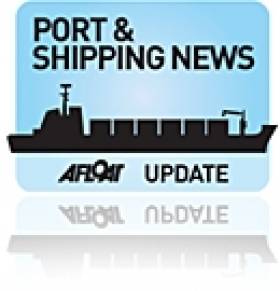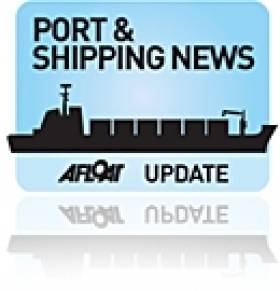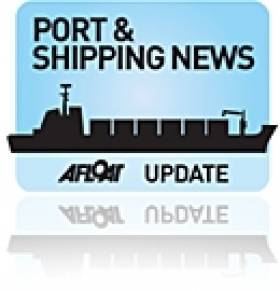Displaying items by tag: Shipping
Irish ships will now be considered of the highest quality and will be subject to less inspections in ports throughout the region following an international meeting in Dublin today.
The Paris Memorandum of Understanding on Port State Control (Paris MoU) held its 43rd Committee meeting in Dublin, Ireland from 10 - 14 May 2010. The meeting was held in the Dublin Castle Conference Centre and was opened by Minister of Transport Mr Noel Dempsey TD. The meeting was chaired by Mr. Brian Hogan (Chief Surveyor of the Marine Survey Office), at the Department of Transport.
The Paris MoU adopted the new "Black/Grey/White List" which is the international league table of maritime flag states. Ireland is on the white list of best performing States and moved from 19th on the list to 8th place this year. This means that Irish ships will now be considered of the highest quality and will be subject to less inspections in ports throughout the region. This will have positive financial consequences for the Irish shipping industry.
The meeting adopted the "New Inspection Regime" (NIR), which is a groundbreaking development in Port State Control. The New Inspection Regime, which will enter into force from 1 January 2011, and will replace the existing Port State Control system. The NIR was developed following a process of review of the existing Port State Control mechanism. The NIR is a significant departure as it is a risk based targeting mechanism, which will reward quality shipping with a smaller inspection burden and concentrate on high-risk ships, which will be subject to more in-depth and more frequent inspections. The NIR is based on the latest developments at the International Maritime Organization, IMO, and makes use of company performance and the IMO audit for identifying the risk profile of ships together with the performance of the flag State and the recognised organisation. The past inspection record of the ship as well as the ship's age and ship type will influence the targeting. Full implementation of the system will rely on collection of port call information. The NIR will be accompanied by a new information system "THETIS" which will replace the current SIReNaC information system.
The Committee looking ahead and recognising that the International Labour Organisation's Consolidated Maritime Labour Convention, 2006, MLC 2006, may enter into force from 2011 onwards considered draft guidelines for Port State Control Officers in respect of the implementation of the Port State Control requirements of the Convention. These guidelines will be based on the MLC 2006 and should become a practical tool for inspections on working and living conditions and will ensure that seafarers will be protected. The Committee also adopted new guidance on control of International Safety Management, ISM, Code requirements, taking into account experience gained since the entry into force of the ISM Code. The Committee continued to take actions in response to the 2nd Joint Paris/Tokyo MoU Ministerial Conference, held in Vancouver in 2004 and agreed that all actions have been completed or will be monitored on a continuous basis.
The results of the Concentrated Inspection Campaign on Lifeboat Launching Arrangements were considered by the Committee and it was agreed that the evaluation will be submitted to the International Maritime Organization in 2011. From September to November this year the Paris MoU will focus its campaign on damage stability of oil tankers, which is seen as an important issue and the results will be communicated to the international shipping community.
The Paris MoU has increasing relations with port State control regimes in other areas of the world. The meeting heard reports from the US Coast Guard, the Caribbean MoU, Black Sea MoU, Riyadh MoU and Tokyo MoU. The International Labour Organization was also represented and provided updates. Malta and Croatia will join the MoU Advisory Board (MAB) of the Paris MoU for the coming 3 years and the Committee thanked the outgoing MAB members Russian Federation and Sweden for their positive contributions over the past period.
ENDS
The MV Linda is to be rechristened the Rachel Corrie on Wednesday, May 12th, at 10am in Dundalk Port, in honour of the 23 year old American peace activist who was killed during a non-violent protest to stop Israeli forces bulldozing the home of Palestinian family in Gaza, in 2003.
Afterwards the vessel will set out on its voyage to Cyprus where it will join other vessels in bringing urgently needed medical, educational and construction supplies to the people of the Gaza strip.
Background: The 1,800 tonne vessel was purchased by the Free Gaza Campaign for €70,000 at an auction in the Crown Plaza hotel, Dundalk, on March 30th. The proceeds from the sale were used to pay arrears owed to the, mainly Ukrainian, crew who were abandoned by the ship’s owners at Dundalk Port last July.
The vessel was seized and auctioned by order of the High Court following an application by International Transport Federation inspector, and SIPTU official, Ken Fleming.
Today Mr Fleming said the ITF “welcomes the fact that the mv Rachel Corrie will be put to a better, more humanitarian use than the exploitation of sea-farers. The Irish Government must do more to stop the exploitation of sea-farers coming into our ports.
“Meanwhile I will be there on Wednesday, on behalf of the ITF and SIPTU to wish the new owners God speed”.
Irish Ports and Shipping recover from record falls
The Irish ports and shipping sectors began to show positive signs of recovery towards the last quarter of 2009 following a record fall in volumes earlier in the year as the downturn in the economy bit hardest, according to the latest edition of the Irish Maritime Transport Economist, unveiled today (April 20th ) at an industry briefing in Dublin by the Irish Maritime Development Office (IMDO).
“While the trend for 2009 was negative, we observed that the pace of decline in economic activity moderated significantly from last spring onwards with some volume recovery in several of our domestic shipping segments recorded to the year end,” said IMDO Director, Mr. Glenn Murphy. “The market segments most heavily hit were those related to the construction industry, which suffered severe difficulties in 2009. This resulted in break-bulk volumes in commodities such as timber, aggregates, steel and plaster falling by as much as 49% to pre-boom levels.”
The report highlighted the continued contraction of the Irish economy last year and underlying weaker consumer confidence as the cause of a realignment of demand for shipping volumes across all the key market segments. This resulted in bulk volumes falling to levels last seen in 1995. Unitized segments also saw almost 5 years of volume growth dissipate over the course of 18 months, with lift on/lift off (lo/lo) falling back to 2003 levels and roll on/roll off (ro/ro) back to 2005 levels. The report also suggests that the oversupply of residential property, especially in parts of the country where demand is likely to remain weak for many years, will result in continued low shipping volumes for construction materials.
The lo/lo sector has similarly been a market segment enjoying long periods of double digit volume growth during the consumer driven boom time. This is mainly due to the segment being heavily weighted towards import laden volumes. Lo/lo volumes fell by 21 per cent on an all-island basis last year as consumer spending corrected sharply. The other main market segment, ro/ro, is traditionally heavily weighted towards volume movements to the United Kingdom. Ro/ro volumes fell by 9 per cent as underlying economic and currency issues in both markets continued to dampen demand. Both the lo/lo and ro/ro markets last year continued to undergo significant structural, route and capacity changes as the operators were challenged with having to adapt to rapidly evolving volume patterns and trade adjustments. Ferry passenger volumes remained static with no loss in passenger volumes reported for the year.
“It is largely recognized now that the return to positive economic growth will be export led and as such, the initial stages of our recovery will be mainly influenced by a recovery in the global economy and in particular, by our major trading partners,” said Mr. Jim Power, Chief Economist from Friends First at the event. “
The latest data in the report indicates that we may have passed the trough of the economic downturn that has impacted on shipping volumes, ongoing caveats of currency volatility and steadily increasing oil and bunker prices remain further risks to the recovery process. The Report concludes that, while market conditions remain challenging for many shipping operators, IMDO expect a modest return to volume growth towards the end of 2010.
Warrenpoint Harbour Authority
Warrenpoint Harbour Authority
Warrenpoint Harbour Authority seeks to operate profitably within fair and competitive tariff arrangements so that the Port is economically sustainable. Its aim is to contribute as much as possible to the generation of economic wealth within the Port and its regional hinterland.
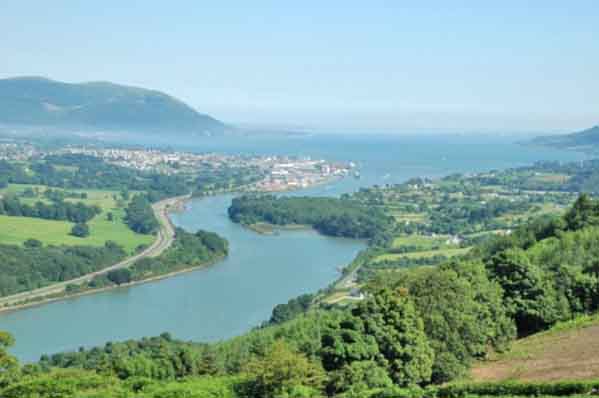
Consequently, profit optimisation, to achieve its primary mission rather than profit maximisation, will be pursued.
History
The original Port of Warrenpoint, consisting of a wet dock and piers, was constructed in the late 1770s by Roger Hall, Robert Ross and Isaac Corry with the assistance of £500 of public funds. In 1919 the heirs of Roger Hall sold the Port to John Kelly and Sons for the sum of £16,000. John Kelly continued to operate the Port until 1971 when it was sold to Warrenpoint Harbour Authority for £369,000.
The Port was substantially enlarged with an initial total investment of approximately £6.7million to create the modern Port of Warrenpoint. Until 1971 the Port of Warrenpoint acted as a lightering port for the Port of Newry and jointly these ports handled approximately half a million tonnes of cargo annually. Subsequently the modern Port of Warrenpoint has handled 5 times as much cargo on an annual basis.
Warrenpoint Harbour Authority, The Docks, Warrenpoint, Co. Down, N. Ireland BT34 3JR. Administration/General Enquiries – Tel: 028 417 73381 • Fax: 028 417 52875. Operations – Tel: 028 417 52878 • Fax: 028 417 73962• Email: [email protected]
Port of Larne
Port of Larne
The history of the Port of Larne stretches from the mists of time in the Middle Stone Ages, through the pre-Christian centuries and the Viking raids, to the more modern history of the 19th and 20th centuries and the development of the most modern facilities and technologies which have made Larne a major channel of commercial and passenger traffic in these islands.
It is a story of vision, ingenuity and hard work which turned a small harbour into a thriving Port. Larne developed significantly from the mid-19th century and particularly after the Second World War when the worldwide revolution in unitized traffic and the increased mobility of tourists led to far-reaching technological and other major changes.
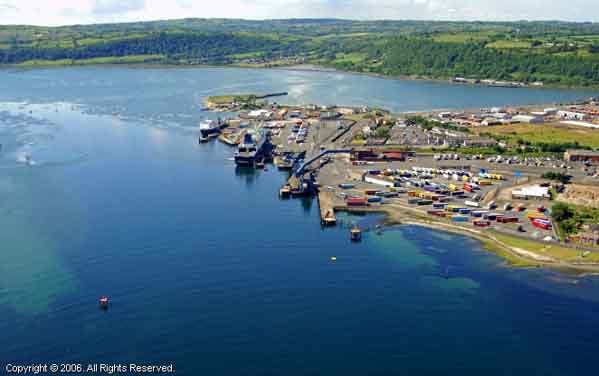
There were years of immense difficulty, including two World Wars, periods of economic depression and times of tragic loss as in the Princess Victoria disaster. However, throughout all these challenges, changes and setbacks, the people of Larne showed remarkable resilience, a determination to learn from the past and to look to the future and a resolve to make Larne the outstanding Port which it is today.
The story of the Port of Larne is also a history of great characters like James Chaine who did most to establish the port in the 19th century, also of Colonel Frank Bustard who in the mid-20th century, had the vision of a new system of moving goods in bulk and who helped to make Larne a most significant part of the container revolution.
Today, Larne is renowned as the premier Port in Ireland. It handles 385, 000 freight units a year, as well as 200,000 tourist vehicles and 750,000 passengers. It is operative 24 hours a day, seven days a week, with up to 30 arrivals and departures daily to and from a number of ports including Troon, Cairnryan and Fleetwood.
History
Larne is believed to have derived its name from Lathar, son of Hugony the Great, High King of Ireland in pre-Christian times who reputedly gave him an area along the Antrim coast roughly from Glenarm to the River Inver which became known in the Gaelic as Latharna. It is recorded that the Roman Emperor Serverus described how, in 204AD a Roman galley bound for Scotland was blown off course to a place called Portus Saxa which was thought to be Larne Lough. The ancient Greeks also had knowledge of the Antrim Coast and Ptolemy, the astronomer and geographer of the 2nd century AD, referred to Islandmagee on one of his maps.
The Viking raiders left their mark and the Lough at one stage was named after a Norse King called Ulfrich. This became anglicised to Wulfrichfjord and eventually Olderfleet which is an integral part of modern Larne. However, while Larne had an undisputed reputation as a good port, the harbour was not being used to its full potential. In the 18th century, there were a number of quays, including the Town Quay which facilitated a lively emigration trade to the United States.
By 1840, the harbour remained underused with only two Larne ships engaged in foreign trade. There was great rivalry between Larne and Donaghdee which had operated a regular service to Portpatrick since 1662. However, this Mail Route was withdrawn by the mid-19th century and the creation of a railway line from Carrickfergus to Larne led to the development of a daily service to Stranraer with a paddlesteamer, the Briton. However, the route did not make profit and the service was withdrawn from 31st December 1863.
In 1866 James Chaine, the son of a prosperous Co Antrim linen merchant bought the harbour with a down payment of £9,000 and changed its fortunes completely. By 1882, Chaine had not only paid off the balance of £10,500 but had also set the Port of Larne on the way to success. He repaired the existing pier and quays and had them extended and developed a rail link to the Port. In 1871 the Larne and Stranraer Steamboat Company was formed and a new paddle steamer the Princess Louise commenced a regular service between the two ports on 1stJuly 1872.
A mail route was established in 1875 and a trans-Atlantic service between Glasgow, Larne and New York began in 1873. Using the renowned State Line vessels, this service continued until December 1889 and many hundreds of emigrants left Larne to start a new life in America.
Sadly James Chaine died from pneumonia in 1885 at the age of 44 and the town and port lost a remarkable visionary. As a mark of respect the people of Larne and district raised funds by public subscription to build the Chaine Memorial Tower which dominates the entrance to the harbour.
20th Century
The Port of Larne continued to prosper in the 20th century. In 1912 the old Larne Harbour Company was replaced by a new company, Larne Harbour Limited, with its new Chairman, Charles MacKean, who remained in office until his death in 1942. In 1914 Larne made the headlines when the largest consignment of arms was landed at the Port during the Ulster Unionists' opposition to Home Rule for Ireland. The crisis was subsumed by the outbreak of the First World War when Larne became a Naval Port where its location rendered it a particularly good anti-submarine base.
The political upheavals after the end of the War and the partition of Ireland had an adverse effect on the Port. This created uncertainty and unrest which led to a sharp decrease in traffic between Scotland and Ireland. There was an attempt to establish a fish-processing business at Larne which ended in failure. By the end of the Thirties, however, the Company was in a better position to expand and the creation of the first proper loading ramps for motorised vehicles gave a hint of what was to come.
Second World War
The Port of Larne played a major role in the Allied Forces efforts during the second World War. More than 5 million people passed through the Port, including 4.3million service personnel. Among these were American troops preparing for the Normandy D-Day landings in 1944. As the War drew to a close and the number of troops and volume of transport decreased, the Port began to return to its pre-war level of activity. However, there was no going back to the past and the challenges, party arising out of the War, were to develop Larne as a major Port in the British Isles.
Post-War
A major figure in the post-war development was Colonel Frank Bustard who was a latter day version of the modern entrepreneur Sir Richard Branson. Bustard's earlier attempt to develop a cheap trans-Atlantic service in opposition to the Cunard Line failed to attract enough backers due to the negative attitude of the government. His ideas were overtaken by the Second World War in which he served with distinction but after the War he developed a brilliant new idea which led to the formation for the profitable freight trade business. This rapidly became the foundation for Larne's rapidly growing success.
Frank Bustard turned his attention to the possibilities offered by converted Naval tank landing ships (LSTs) which had made such a significant contribution to the Allied invasion of Europe. He discovered that these could be adapted to carry cargo driven onboard and in simple form, the RO/RO revolution began. Bustard chartered three LST vehicles and formed the Transport Ferry Service which established a service between Preston and Larne in 1948.
This service began paying its way in 1952 but navigational difficulties at the Preston end and a prolonged strike at the English Port in 1969 spelt the beginning of the end of the Larne-Preston service which ceased in 1973. However a remarkable opportunity had arisen in south-west Scotland where the Atlantic Steam Navigation Company which now owned the Transport Ferry Service purchased the then virtually unknown port of Cairnryan.
This port had been built during the Second World War to load ammunition ships for overseas service. It was sold in the Sixties to ASN for the then princely sum of £25,000. However, it was not until 10th July 1973 that the new ASN Larne-Cairnryan service was inaugurated, thus giving Larne access to the shortest crossing on the Irish Sea which it remains to this day. This was to have significant effect on the success of the Port of Larne. Colonel Frank Bustard deservedly was made a Freeman of Larne for his efforts.
Key Developments
The decades from the Fifties to the Seventies witnessed key developments at Larne.
Throughout these decades, with the rapid growth of containerised traffic, the Port became a major link across the Irish Sea. There was a proliferation of loading facilities and new quays, including the extension of the Olderfleet Quay, the construction of the Phoenix and Curran Quays, with the inclusion of Mulberry Harbours from the Second World War and the completion of Castle Quay. Increased facilities meant more sailings and passengers and in 1967 the Mail Quay Passenger Terminal was officially opened.
From the sixties onwards, the Port of Larne developed the Redlands estate at the harbour. Alongside this area, the infrastructure to carry out a new dual carriageway to the Port was developed thus bypassing the town and also to cater for the vastly increased volume of freight and passenger traffic using the harbour.
Passenger and Freight Services
Following the establishment of the new route between Larne and Cairnryan, the holding company Transport Ferry Services was bought by European Ferries which owned Townsend-Thoresen. The take-over by the European Ferries Group intensified the modernisation of the Port and the expansion of facilities continued apace.
The Chaine Quay, named after James Chaine who had put Larne on the map as a port in the 19th century was re-developed and formally opened on 27th June 1978 in the presence of the then Chairman, Major George B. MacKean, the son of the first Chairman of Larne Harbour Ltd, Charles MacKean. Almost a year later, the Continental Quay was officially re-opened. Both these quays provided a double-deck ramp, the first in Ireland, and were installed to cater for the simultaneous working of both decks of the new vessels which were coming into operation on the Irish Sea at that time.
While the passenger and freight service between Larne and Cairnryan grew in popularity, a similar service between Larne and Stranraer which had operated for many years as a Mail Route, also continued to prosper. Tragically, however, the Princess Victoria foundered in heavy seas off the Irish coast on 31st January 1953 with the loss of 133 lives including 27 inhabitants of Larne.
Over the years a series of modern vessels maintained the service on the Larne-Stranraer route including the Caledonian Princess, the Antrim Princess and the Galloway Princess, all of which were seafaring showpieces in their time and which operated under various flags. The closure of the Belfast-Heysham service 1n 1975 generated even more business for the Larne routes to Cairnryan and Stranraer. The freight services continued to be profitable and in addition to the existing routes, new services were established. These included the Larne to Ardrossan route under different operators from 1956 to 1976 and more recently under P&O from 1992 until its relocation to Troon in 2001.
Fleetwood Service
The Larne to Fleetwood Roll On/Roll Off service, operated by Pandoro began in 1975 replacing an earlier LO/LO service operated by P&O Ferrymasters since 1973. This service was particularly popular with hauliers who wanted direct access to North-West England and especially to the motorways near Fleetwood and Liverpool. In the early days, Pandoro operated one ship daily to Fleetwood and another to Liverpool until 2002 when a daily Larne-Liverpool freight service commenced. As part of the service, the vessels provided good cabin accommodation and a free hot and cold buffet.
In 1999 a third vessel was provided for the Fleetwood route to meet the demand from hauliers and also an increasing number of motorists who wanted direct access to the Lancashire coast and the M6 motorway. Early in the year 2000, this RO/RO service celebrated its 25th anniversary which was a testimony to its stability and progress through decades of change in the ferry business.
P&O
In 1986, European Ferries was taken over by P&O and as the new Millennium approached, the last years of the 20th century brought accelerated progress at Larne. Significant improvements were made at the Port. The Mail Quay was totally redeveloped and later renamed the MacKean Quay in honour of the family's long and distinguished association with Larne Harbour Ltd. Construction on the £3.5m scheme which included a two-tier ramp, was partly assisted by the European Regional Fund (ERDF) and the Government Port Modernisation Grants. Over the years ERDF made a major contribution to the development of modern facilities at the Port.
The Quay was formally opened in 1987 by Mrs Patricia MacKean, widow of the former Chairman Major George MacKean. The modernisation of the Port continued and in 1993 the refurbished Curran Quay was formally opened by Gavin Hastings, the Scottish Rugby international and captain of the British Lions.
In 1996 a 2m high-technology Distribution Centre for the storage of fresh and chilled produce was opened on Redlands Estate which had been developed over the years by Larne Harbour Ltd. The opening of a Freight Centre in 1998 enabled drivers to have their vehicles weighed, checked-in and marshalled in a single, smooth and fast operation a good example of the Port identifying customers' needs ahead of demand.
As a further enhancement of the Port's facilities, the Board of Larne Harbour Ltd had been aware for many years of the need to improve the road links on both sides of the channel. This had some effect but much remained to be done. In May 1998 the Government announced a new £10m scheme to improve the approach road to Larne. The construction by Phoenix Gas of a £7m gas pipeline across the Lough and through the Company's land gave local customers a wider choice of energy sources.
The New Millennium
By the beginning of the new Millennium, the Port of Larne was among the busiest on the Irish Sea. The RO/RO facilities dealt with a wide variety of shipping including the most modern high-speed ferries and the port also had the capacity to handle a large range of bulk and general cargo.
At the Port of Cairnryan, splendid new terminal facilities costing £4.5m was opened in April 1999. These included separate reception areas for tourist and freight traffic, new booking and information offices, a baggage-handling area and facilities for children and the disabled.
Though there was steady progress throughout the late Eighties and early Nineties, the shipping company Stena Sealink announced in 1995, its intention to leave Larne and to establish a new route from Belfast to Stranraer. Inevitably there was a downturn in business at Larne but the people and the Port rose to the challenge and by the early years of the new millennium, the number of tourists and commercial vehicles had increased steadily.
The continued commercial confidence at Larne was underlined by significant additions to the shipping fleet. In February 1999, P&O announced an order for European Causeway, a new 21,000 tonne passenger and freight ferry from Mitsubishi of Japan, which came into service in August 2000. The luxurious new vessel with a top speed of 23 knots was designed to reduce the travelling time on the conventional ferry to Cairnryan to just 105 minutes a reduction of 25% on the time taken by the older vessels. A sister ship European Highlander with similarly luxurious facilities and high technology features went into service in July 2002.
The competitive edge to modern ferry travel from Larne had been sharpened some three years earlier with the introduction of the powerful P&O Jetliner, a high-speed ferry with an operating speed of 32 knots. This reduced the Larne-Cairnryan crossing to just one hour, the fastest on the Irish Sea. In Spring 2000, the Jetliner was superseded by the larger and more luxurious Superstar Express.
For the further convenience of passengers, a Call Centre was opened in 1998. Overall the Port of Larne moved into the new Millennium on a sound commercial footing and this was in no small measure due to its strength in depth as part of the P&O Group.
The Port of Larne has developed dramatically since it's origin in the mists of time. It had risen to the commercial challenges of succeeding centuries, survived the trauma of two World Wars and positioned itself to take advantage of the latest technological developments in the world of shipping and freight to gain a deserved reputation as the premier Port in Ireland.
Now in the early years of the third Millennium, it is well placed to continue its momentum as a top-class facility and to keep faith not only with its passengers and freight customers but with all those down the years who worked hard to make the Port of Larne what it is today.
This history is provided by Alf McCreary.
The definitive history of the Port of Larne is contained in the hard-back book by Alf McCreary title, A Vintage Port – Larne and it's People. Published by Greystone, it is priced at £14.95 and is available from all good bookshops and also on Larne ferries.
Port of Larne, 9 Olderfleet Road, Larne, Northern Ireland BT40 1AS. Tel: 028 2887 2100 • Fax: 028 2887 2209 • Email: [email protected]
Dundalk Port Company
Dundalk Port Company
The Port is owned by Dundalk Port Company and is located on the North East coast of Ireland. It is ideally located as a gateway between Northern Ireland and the Republic of Ireland.
The Port, situated almost exactly halfway between the cities of Belfast and Dublin, enjoys major road connections to both cities via the N1 national primary road. This enables easy transportation of goods to both cities from Dundalk in about an hour.
The port offers a range of services including general cargo handling, pilotage, customs, etc.
Pilotage – Dundalk Port Company also provide a compulsory pilotage service which leads ships up the 8km stretch from the open sea. The Port is serve by a main pilot boat and an auxiliary boat.
Facilities – Ships of up to 3,500 dwt and 106m in length can be handled. Five 30-tonne crawler cranes at minimum radius are capable of discharging up to 160 tonnes per hour each. Ships of upto 3000 tons can be discharged in 12 hours.
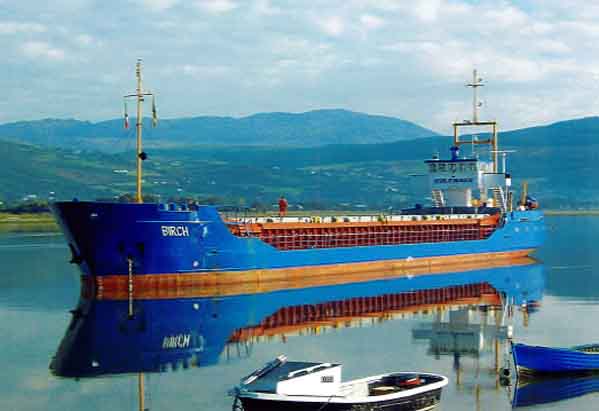
About Dundalk Port
Dundalk Port has a long tradition of shipbuilding and registration.
The Port also has a long history of trading in different products with traffic through the port having consisted of gypsum, perlite, sand, peat, salt, scrap, pit props, cattle, fertilizers, machinery, paper, wood and general cargo to name a few.
The First vessel recorded as trading to Dundalk was the Trinitic which sailed from Liverpool to Dundalk in March, 1580. The year 1646 saw a grant of 'perfect freedom of trade' to Dundalk.
The harbour was naturally shallow and was left to its own devices until, in 1721 Lord Limerick, who at that time was high sheriff of Co. Louth, made a deal with the corporation to construct a harbour.
In 1740 he set about the construction of a quay in the form of a pier, extending into the river upstream from the present harbour. In 1767 the Irish Parliament voted £2000 and £400 yearly to improve the harbour. This sum was paid for 8 years and amounted in all to £5,200.
Early in the year 1800 Lord Roden appointed a harbour master and claimed authority over the harbour works. In 1803 the new Custom House was built and there was a military guard placed where goods were stored at the quays.
In 1840 an Act 'for regulating, preserving, improving and maintaining the river, port and harbour of Dundalk"'was passed. Under this act, 27 commissioners were appointed who had certain shipping and property qualifications.
In August 1848 a contract was signed and accepted for the construction of the pile lighthouse. The lighthouse was completed in June 1855. Soon after, in November 1860, a fog signal bell came into operation.
In 1967 work began to convert the lighthouse to electric and unwatched. The new light was exhibited on 17th December, 1968 with an increased intensity to 187,000 candle power in the white sectors. The fog horn signal was established on 25th June 1969.
In 1968 the B&I ended its Dundalk–Newry–Liverpool service. The last four ships on this service were MV Dundalk, MV Inniscarra, MV Wicklow and MV Kilkenny. The B&I compound was sold to the McGinnty family who used the premises for grain warehousing. This premises is now in the hands of Lockingtons Shipping, a subsidiary of Dundalk Port Company.
Towards the latter end of the 20th century, extensive work was carried out on the quays to repair, maintain and extend them to their current status. 220 metres of the current 400 metres of quay wall were just recently constructed in 1992.
In response to the steady rise in port traffic, 2 separate quays were linked with a new 25 metre stretch to form a single long, linear quay.
In 2002 Dundalk Port became a semi state limited company owned by the state. Captain Frank Allen is Chief Executive of Dundalk Port Company.
For a location map, please click here
Dundalk Port Company, 40 Quay Street, Dundalk, Co. Louth. Tel: 00353 (0)42 9334096 • Mobile: 00353 (0)87 2566594 • Fax: 00353 (0)42 9335481 • Email: [email protected]
Irish Sea Shipping
Shipping News & Views from the Irish and Celtic Seas since 1995.
Topics covered on the site:
Marine Radio
Maritime Events
Maritime Features
Maritime Queries
Irish & Celtic Sea Cruise Ship Calls
WSS Branch Programmes
News
Photographic Galleries
Publication Reviews
Extensive Web Links
Irish Ships and Shipping
The aim of the Irish Ships and Shipping site is to record ships and shipping of Irish interest with photos, details and stories from all interested parties. Of particular interest would be any photos or stories of Irish Shipping Ltd., its ships, and the men who worked them



























